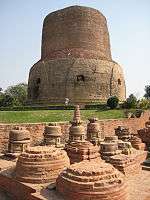Dhamek Stupa
| Dhamek Stupa धामेक स्तूप (Hindi) | |
|---|---|
 | |
 Shown within India | |
| Basic information | |
| Location |
|
| Geographic coordinates | 25°22′51″N 83°01′28″E / 25.3808°N 83.0245°ECoordinates: 25°22′51″N 83°01′28″E / 25.3808°N 83.0245°E |
| Affiliation | Buddhism |
| Architectural description | |
| Architectural type | Stupa |
| Completed | 500 CE |
Dhamek Stupa (also spelled Dhamekh and Dhamekha, traced to Sanskrit version Dharmarajika Stupa, which can be translated as the Stupa of the reign of Dharma) is a massive stupa located at Sarnath, 13 km away from Varanasi in the state of Uttar Pradesh, India.[1]
Stupas originated as pre-Buddhist tumuli, in which ascetics were buried in a seated position,[2] called chaitya.[3] After the parinirvana of the Buddha, his remains were cremated and the ashes divided and buried under eight mounds with two further mounds encasing the urn and the embers. Little is known about these early stupas, particularly since it has not been possible to identify the original ten monuments. However, some later stupas, such as at Sarnath and Sanchi, seem to be embellishments of earlier mounds.[4] The Dhamek Stupa was built in 500 CE[5] to replace an earlier structure commissioned by the great Mauryan king Ashoka in 249 BCE, along with several other monuments, to commemorate the Buddha's activities in this location. Stupas originated as circular mounds encircled by large stones. King Ashoka built stupas to enshrine small pieces of calcinated bone and other relics of the Buddha and his disciples.[6] An Ashoka pillar with an edict engraved on it stands near the site. This is nothing but the great place to visit in Varanasi. Anyone who is planning to visit Varanasi, he should surely be going out there. The Dhamek Stupa is said to mark the spot (Rishipattana which can be translated as "where the Rishi arrived") where the Buddha gave the first sermon to his five disciples after attaining enlightenment,[7][8] "revealing his Eightfold Path leading to nirvana".[9] In several of the ancient sources the site of the first sermon is mentioned to have been at a ″Mriga-dayaa-vanam″ or a sanctuary for animals. ( In Sanskrit mriga is used in the sense of game animals, deer being the most common). The last royal endowment at the site is dated to about 12th c. CE, after which the location of the Mrigadayavanam seems to have been lost even to the devout. The stupa was enlarged on six occasions but the upper part is still unfinished.[10] While visiting Sarnath in 640 CE, Xuanzang recorded that the colony had over 1,500 priests and the main stupa was nearly 300 feet (91 m) high.[11]
In its current shape, the stupa is a solid cylinder of bricks and stone reaching a height of 43.6 meters and having a diameter of 28 meters. It is the most massive structure in Sarnath.[12] The basement seems to have survived from Ashoka's structure: the stone facing is chiseled and displays delicate floral carvings of Gupta origin. The wall is covered with exquisitely carved figures of humans and birds, as well as inscriptions in the Brāhmī script.[13]
The Dhamek Stupa features in the 2014 Indian mystery thriller novel The Emperor's Riddles by Satyarth Nayak.
_(14583657009).jpg)
Gallery
 Dhamekh Stupa, Saranath
Dhamekh Stupa, Saranath History of Dhamekh Stupa on stone
History of Dhamekh Stupa on stone Dhamekh Stupa close-up, Sarnath
Dhamekh Stupa close-up, Sarnath Dhamekh Stupa wall Close Up
Dhamekh Stupa wall Close Up
References
| Wikimedia Commons has media related to Dhamekh Stupa. |
- ↑ http://www.iloveindia.com/indian-monuments/dhamekh-stupa.html
- ↑ "Buddhist Art and Architecture: Symbolism of the Stupa / Chorten". 2006-08-14. Retrieved 2013-01-07.
- ↑ "THE BUDDHIST STUPA: ORIGIN AND DEVELOPMENT". 2005-01-13. Retrieved 2013-01-07.
- ↑ Possehl, Gregory L (2010). The Indus Civilization: A Contemporary Perspective. AltaMira. p. 12. ISBN 978-0759101722.
- ↑ Sir Banister Fletcher's a History of Architecture, 20th ed. (ed. by Dan Cruickshank). Architectural Press, 1996. ISBN 0-7506-2267-9. Page 646.
- ↑ "Stupas". Indian Heritage. Retrieved 2006-11-20.
- ↑ "Place of the Buddha's First Sermon". Indian architecture. Retrieved 2006-09-19.
- ↑ "http://www.asia.msu.edu/southasia/india/culture/architecture.html". Retrieved 2007-02-08. External link in
|title=(help) - ↑ Quoted from: Pippa de Bruyn, Niloufer Venkatraman, Keith Bain. Frommer's India. ISBN 0-471-79434-1. Page 340.
- ↑ Bradnock, Robert W. Footprint India. Footprint Travel Guides, 2004. ISBN 1-904777-00-7. Page 191.
- ↑ Arnett, Robert A. India Unveiled. Atman Press, 2006. ISBN 0-9652900-4-2.
- ↑ "Dhamekh Stupa". Varanasicity.com. Retrieved 2006-10-16.
- ↑ "Dhamekh Stupa". Retrieved 2006-09-19.